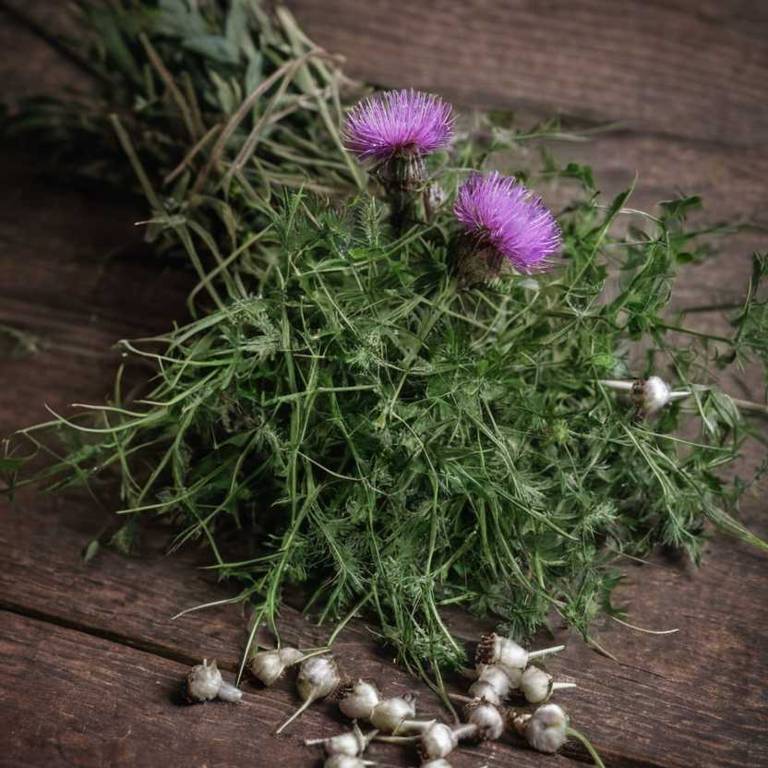By Leen Randell
Updated: Jul 10, 2024
What to know about Cirsium eriophorum (woolly thistle) before using it medicinally

Cirsium eriophorum, commonly known as woolly thistle, is a herb that has been prized for its medicinal properties, which include anti-inflammatory and antioxidant effects, helping to alleviate conditions such as arthritis and digestive issues.
It is also valued in horticulture for its showy, white flowers and robust growth habit, making it a popular ornamental plant for gardens. Botanically, Cirsium eriophorum is a perennial species of thistle in the Asteraceae family, characterized by its distinctive, downy leaves and stems.
Historically, this herb has been used in traditional medicine for centuries, with references to its use dating back to the Roman naturalist Pliny the Elder.
This article explains the medicinal, horticultural, botanical, and historical aspects of Cirsium eriophorum.
What are the medicinal properties of Cirsium eriophorum?
Cirsium eriophorum helps with skin irritations, wounds, and digestive issues due to its anti-inflammatory and antimicrobial properties. The plant has been used in traditional medicine for centuries to treat various conditions, including fever, rheumatism, and respiratory problems.
The active constituents responsible for the medicinal properties of woolly thistle include sesquiterpene lactones, flavonoids, and saponins. These compounds have been shown to have anti-inflammatory, antioxidant, and antimicrobial activities, which contribute to the plant's therapeutic effects.
The most commonly used parts of woolly thistle for medicinal purposes are the leaves, stems, and roots, which are typically harvested in the summer months. The leaves and stems are rich in sesquiterpene lactones, while the roots contain higher levels of saponins and flavonoids.
Ingestion of large quantities of woolly thistle can cause gastrointestinal upset, including diarrhea and abdominal pain. External use of the plant can cause skin irritation, especially in individuals with sensitive skin.
When using woolly thistle medicinally, it is essential to note that the plant is not recommended for pregnant or breastfeeding women, as it may stimulate uterine contractions and affect milk production. Additionally, individuals with allergies or sensitivities to plants in the Asteraceae family should exercise caution when using woolly thistle.
What are the horticulural aspects of Cirsium eriophorum?
Cirsium eriophorum grow well in full sun to partial shade with well-drained soil and a pH range of 6.0-7.0. They prefer dry to moist conditions and can tolerate drought. Watering should be done regularly, especially during hot summer months.
For successful planting, sow Cirsium eriophorum seeds directly outdoors in the fall or spring, 1/4 inch deep and 12-18 inches apart. Transplants can also be used, but they may require staking to prevent stem damage. Soil should be loosened to a depth of 12 inches to ensure good root growth.
Harvesting can be done when the plant is in bloom, typically in mid to late summer. Cut the stems to encourage new growth, and remove the flower buds to direct the plant's energy towards seed production. Leave some stems intact to allow for seed dispersal.
Common pests affecting Cirsium eriophorum include thrips, spider mites, and caterpillars. Diseases such as powdery mildew, leaf spot, and root rot may also occur, often caused by overwatering or poor air circulation. Regular monitoring and proper management practices can help prevent infestations and infections.
What are the botanical aspects of Cirsium eriophorum?
Cirsium eriophorum is a perennial plant that belongs to the family Asteraceae. Its stem is erect, branching, and can grow up to 30-60 cm tall, with a woody base that is often covered with a thick layer of woolly hairs.
Cirsium eriophorum is classified under the following taxonomic hierarchy: Kingdom: Plantae, Clade: Angiosperms, Clade: Eudicots, Clade: Asterids, Order: Asterales, Family: Asteraceae, Subfamily: Carduoideae, Tribe: Cirsieae, Genus: Cirsium, Species: C. eriophorum. It is closely related to other Cirsium species.
Cirsium eriophorum has several variants, including C. e. eriophorum (typical form), C. e. glabrescens (hairless form), and C. e. viciense (rare form found in central Italy). These variants differ in their hairiness and leaf shape.
Cirsium eriophorum is found in the Mediterranean region, specifically in countries such as Spain, France, Italy, Greece, and Turkey. It typically inhabits dry areas, including rocky slopes, scrublands, and open forests.
The life cycle of Cirsium eriophorum involves germination, vegetative growth, flowering, seed production, and seed dispersal. It typically begins in spring, with new shoots emerging from the underground rhizome. The plant blooms in late spring, producing purple flowers with prominent stamens and styles. Seeds are produced in late summer and are dispersed by wind and animals.
What are the historical aspects of Cirsium eriophorum?
Cirsium eriophorum is a plant with a long history of medicinal and edible uses. In medieval Europe, the leaves and flowers were used to treat ailments such as fever, rheumatism, and digestive issues. The plant was also used as a food source, with the young shoots eaten raw or cooked.
In ancient Greek mythology, the woolly thistle was associated with the goddess Artemis, who was often depicted with a crown of thistle flowers. The plant was also linked to the story of the goddess's ability to heal the sick. The Greek physician Hippocrates is said to have used the plant in his treatments.
In many cultures, the woolly thistle is a symbol of protection and resilience. The plant's prickly leaves are said to ward off evil spirits, while its ability to thrive in harsh conditions is seen as a metaphor for overcoming adversity. In some Christian traditions, the thistle is associated with the Virgin Mary.
The woolly thistle is mentioned in several historical texts, including the Greek physician Dioscorides' De Materia Medica. The Roman naturalist Pliny the Elder also wrote about the plant's medicinal properties in his Naturalis Historia. In addition, the plant is described in the 16th-century herbal text, the Herbal of John Gerard.
Archaeological evidence of woolly thistle use includes ancient artifacts such as ceramic vessels and metal figurines found in ancient Greek and Roman archaeological sites. These artifacts often feature images of the plant or its flowers, suggesting its importance in ancient cultures.